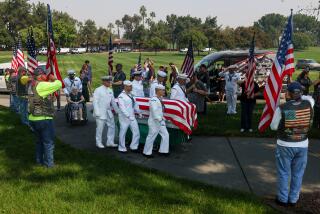Navy Finds Iowa Explosion Was Result of ‘Suicidal Act’
- Share via
WASHINGTON — The Navy has determined that the battleship Iowa explosion that killed 47 sailors last April was caused by a “suicidal act” by Gunner’s Mate Clayton M. Hartwig, who died in the blast, according to congressional officials who were briefed on the Navy’s investigation.
The 1,100-page Navy investigation report, due to be released today, said that extensive tests showed Hartwig had loaded a shell improperly into one of the ship’s 16-inch guns to make room for a homemade detonator that triggered the devastating blast.
Hartwig pushed the shell several inches further forward in the gun barrel than it should have been to leave a space for the device between the first and second silk-wrapped bags of gunpowder, which are loaded directly behind the shell.
Painstaking forensic tests, which cost the Navy more than $4 million, found traces of a “foreign object” that proved to be the detonator, sources said.
“They have very specific material evidence” that points to a deliberate suicidal act, said a member of the House Armed Services Committee, who was briefed on the Navy report. “They have ruled out everything except suicide,” the official said.
The Navy also prepared a detailed psychological profile of the young sailor, which concluded that he was suicidal and had told friends that he “wanted to die in action and be buried at Arlington” National Cemetery.
The Navy briefers made no mention of Hartwig’s alleged homosexuality, which had been an earlier focus of the investigation. Hartwig, 24, had been rumored to be despondent over his rejection by a recently married male shipmate, Petty Officer Kendall L. Truitt.
Hartwig’s parents and sister, Kathleen M. Kubicina, are to be briefed on the report by a Navy captain this morning at her home in Cleveland. Naval officers also fanned out across the nation to relay the report’s findings to the families of each of the 47 sailors who died in the explosion.
Contests Conclusions
On Wednesday, Kubicina vigorously contested the Navy’s conclusions.
“My brother . . . was not a depressed, despondent, suicidal murderer,” said Mrs. Kubicina, who had written to many U.S. officials in Hartwig’s defense after her family learned that he had made Truitt the beneficiary of a $100,000 life insurance policy.
The Navy will not accept blame for the explosion and the sailors’ deaths, beyond admitting failure to recognize Hartwig’s psychological problems and remove him from such a sensitive post, sources said.
The investigation uncovered laxity in crew training and gun maintenance aboard the Iowa, “but they didn’t contribute” to the deadly explosion, sources said.
The explosion occurred as the No. 2 gun, the middle gun of three in the second turret, was being loaded for gunnery practice off Puerto Rico.
Speculation About Powder
The guns and turret were designed in the late 1930s and use powder and shells manufactured more than 40 years ago in World War II. There had been speculation that the powder had been improperly stored and had become unstable. The Navy apparently rejected that as a cause of the blast.
Navy officials had warned that the massive physical damage caused by the explosion and the deaths of all eyewitnesses would result in a largely inconclusive report. But they cited the decades-long history of safe firings from the 16-inch guns and said they would return to full service shortly after the report is made public.
A day after the April 19 explosion, Adm. Carlisle A. H. Trost, chief of naval operations, declared a moratorium on the firing of the unique guns, which are in use only on the nation’s four recommissioned battleships. In June, the Navy partly lifted the ban, allowing ships on deployment to use the guns to carry out military operations.
Doubts Ship at Fault
“I put a restriction on the firing of the guns in the event that something is found that is common to the class. I doubt that will be the case, and I’m hopeful that the investigating team will find the actual cause of the explosion,” Trost said recently.
In late May, the Navy officially confirmed long-circulating reports that the investigation had “a criminal aspect to it,” focusing on Hartwig and his relationship with Truitt. The two had been close friends, but with Truitt’s marriage, they had drifted apart, Navy investigators found.
The inquiry focused early on the possibility that Hartwig and Truitt could have plotted together in a murder-suicide pact, according to reports. Truitt and his Miami attorney, Ellis Rubin, have widely denied those conjectures. On Wednesday, Rubin said his client planned to bring suit against the federal government for defamation of character.
‘We Want an Apology’
“Kendall Truitt’s has become a household name around the world as a possible homosexual somehow involved in a homicidal plot, and we want an apology from those who leaked it in the first place,” Rubin said.
Immediately after hearing the results of the six-month investigation, Rep. Charles E. Bennett (D-Fla.), chairman of the House Armed Services seapower subcommittee, sent a letter to Navy Secretary H. Lawrence Garrett III demanding that the Navy revise its procedures to prevent a repetition of the Iowa incident.
Bennett said he urged the Navy to require two other sailors to inspect the work of the gunner who actually loads the charge into the battleship’s 16-inch guns to ensure that he is following proper procedures.
Briefing at Pentagon
The Navy plans to make the report public this morning at the Pentagon, showing videotapes of the firing tests and releasing a summary of the 1,100-page investigative report prepared under the direction of Rear Adm. Richard D. Milligan.
More to Read
Sign up for Essential California
The most important California stories and recommendations in your inbox every morning.
You may occasionally receive promotional content from the Los Angeles Times.














